August 2000 Article Turbo Tennis Archives:
Tennis Server
|

 |
Well, it is now August, and hopefully you are in top singles form. Those of us who live above the equator are rapidly approaching the end of Summer. Soon, we will be involved in end of season championships (USTA, League, Interclub, etc.). In all probability, many of us will be playing doubles as part of our end of outdoor season tournament schedule. Those of you who play intercollegiate tennis in America will soon be back to school. It is not unlikely that you will be playing doubles as part of the Fall season. Finally, we will be approaching the colder months and will likely be playing doubles as part of our Winter training. This month, I am dedicating my column to those of you who participate in the great game of doubles. For those of you who avoid doubles like the plague, I hope that some of what I present this month will inspire you to engage in this brand of tennis. There are many good reasons why one should play doubles. First, doubles is a game of control…not power. Many, if not most, of us could significantly benefit from improved control in our singles play. Doubles will go a long way toward helping enhance your ball control. Second, doubles is a game that involves net play. If you are the type of player who only comes to the net to shake hands, doubles will open a whole new world of tennis. Like it or not, you will learn to serve and volley. Although this may not be your preferred playing style, it certainly is a desirable option when playing singles. Finally, doubles will introduce the concept of team competition to your tennis experience. One of the things that is conspicuously lacking in singles is the camaraderie and support that being a member of a team can provide. Leagues and interscholastic/intercollegiate play do provide this sense of being part of a team. But nothing can replace the bond that can exist between doubles partners. Sometimes, I watch doubles teams and realize that the players are at a complete loss. One can immediately see that some teams are like fish out of water. They seem to struggle from the first point to the last. Frequently, these teams lose and have no idea why or how. In coaching a college men’s tennis team, I often times must play teams that are comprised of singles-minded players. Although these players may possess good singles games and strategies, they are at a disadvantage in doubles. Yet, the doubles points in intercollegiate competition can make the difference between a team victory or loss. What I have discovered is that employing different doubles formations can greatly increase the likelihood that such a team will emerge victorious. So, let’s begin with the most undesirable doubles formation. This formation has one player at the net and one player behind the baseline at all times! The server or receiver (as the case may be) never come to the net. Rather, they stay back as would be their preference when playing singles. Frequently, they lob high, deep and cross court…which is really the only safe play that they have. All too often, they hit a ball that makes their partner at the net a likely target for being "pegged" (hit by a ball). If you and your partner play this style of doubles, you might as well give up the game! No one can win consistently using this formation because it violates one of the fundamental precepts of the game…control the net. If you watch the pros play doubles, you will see that they often use what I call the classic doubles formation. The server and receiver stay behind the baseline. However, the server will serve and approach the net for a volley, and the receiver will chip and charge the net. In each situation, the goal is to have both members of the team at the net volleying. This is the most offensively desirable position in doubles. If you take a look at the following illustrations, you will see that I have drawn the movement pattern of the server and the potential movement pattern of her/his partner. 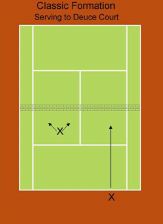 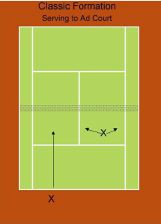 When playing classic doubles formation, the receiver should try to hit the return crosscourt at the server’s feet. Hitting the ball to the net player on the return will often lead to a cross court volley that is directed at your partner. Frequently, this volley will "jam" your partner and she/he will be unable to reply. If your team is serving, the net player can sometimes "poach" (move to the center of the court near net) to hit a put away volley. This is common when the service returns are coming high over the net (making the volleyed put away much easier to hit). As a starting point, I recommend that any team employ this classic formation. Why? Well, it is a strategically sound way to play and it has the added benefit of being the same formation whether a team is serving or receiving. However, if a team is serving from this formation and is losing points and games, a different formation may be in order. This is particularly true if the opposing team’s crosscourt returns are landing at the server’s feet as she/he approaches the net. My first choice for an alternative formation in this situation is what is called the Australian formation. Here, the server and net player are on the same side of their court. Look at the following diagrams: 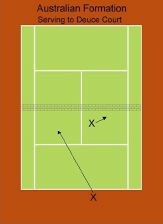 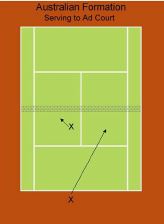 You will see that the server moves to the net but in a very different direction. If serving to the deuce court, the serving team’s net player is on the deuce side of the court. The server must serve and then approach the net on the ad side (the exact opposite from what he/she would do using classic formation). The advantage to this formation is twofold. First, it gives a very different look to the other team. Second, it takes away the cross court return…why?…because the net player is standing where a cross court return would be directed. This net player can easily volley and put away such a return. My second option, when finding that the classic formation is not successful, is to use what is known as the "I" formation. Here, the server stands near the center hash mark when serving to either deuce or ad court (of course, not crossing over into illegal territory). The net partner is crouched down low and is standing on the center service line. The net player must be crouched to allow for the serve to pass over him/her if it is directed down the "T." Take a look at the following diagram. Finally, I will at times encourage teams to use what I call the 2 Back Rushing Formation. Here, both server and her/his partner are back at the baseline (the non-serving team member is a little inside the baseline). When the serve is hit, both server and partner go forward to the net. The sheer visual motion associated with this formation is enough to unsettle many receiving teams. I use this formation when both players of a team have questionable volleys. Why? Well, often times the return will be hit in such a manner that the serve team members can half volley or groundstroke the opposing team's return. This is not my favorite formation, but it is useful if one or both players have difficulty volleying. Better to have to hit half volleys and groundstroke put aways, than to try to hit volleys which neither player possesses. 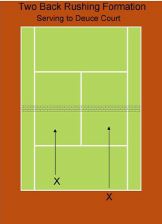 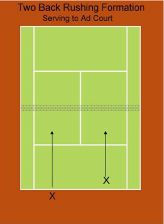 When serving from the Australian formation, most of your serves should be directed down the "T" (for both ad and deuce court serves). If you serve wide from this formation, you run the risk of having the returner hit a down the line return for a clean winner. You can sneak in a wide serve now and then. But, make certain that it is very wide and has spin on it. Otherwise, you will be giving the opponent a clear opportunity to pass you as you approach the net. When serving from the "I" formation, any serve is possible. If you and your partner communicate well, you will discover serve placements that are best for the direction in which the net person is breaking. The "I" formation has myriad combinations of serves and player movements. For this reason, the "I" formation is, in my opinion, the most flexible. You will often see better teams on the pro circuit utilize this formation…particularly when the cross court return from their opponents is difficult to handle. Well, there you have it. Trying different doubles formations can make the game more interesting and increase your chances of winning. I am certain that if you and your partner incorporate different formations into your doubles arsenal…in no time…you will become tennis overdogs!
1996 - 2002 | 2003 - Present
This column
is copyrighted by Ron Waite, all rights reserved. Questions and comments
about these columns can be directed to Ron by using this form.
Ron Waite is a certified USPTR tennis instructor who took up the game
of tennis at the age of 39. Frustrated with conventional tennis methods
of instruction and the confusing data available on how to learn the
game, Ron has sought to sift fact from fiction. In his seven years of
tennis, Ron has received USTA sectional ranking four years, has successfully
coached several NCAA Division III men's and women's tennis teams to
post season competition, and has competed in USTA National singles tournaments.
Ron has trained at a number of tennis academies and with many of the
game's leading instructors.
In addition to his full-time work as a professor at Albertus Magnus
College, Ron photographs ATP tour events for a variety of organizations
and publications. The name of his column, TurboTennis, stems from his
methods to decrease the amount of time it takes to learn and master
the game of tennis.
|



October 2022 Tennis Anyone: Patterns in Doubles by John Mills. September 2022 Tennis Anyone: Short Court by John Mills. |
 You will join 13,000 other subscribers in receiving news of updates to the Tennis Server along with monthly tennis tips from tennis pro Tom Veneziano.
You will join 13,000 other subscribers in receiving news of updates to the Tennis Server along with monthly tennis tips from tennis pro Tom Veneziano. 
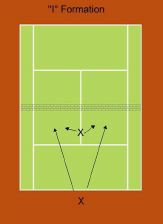 Before the point begins, the serve team decides which way the net person will break after the serve (to his/her left or to his/her right). The server will go to the opposite side of the court. This formation is very deceptive because it never betrays where either player will be headed before the point begins. Frequently, the serve returner will hit directly at the serving team’s net player. This usually results in an easy put away volley for the serve team’s net player.
Before the point begins, the serve team decides which way the net person will break after the serve (to his/her left or to his/her right). The server will go to the opposite side of the court. This formation is very deceptive because it never betrays where either player will be headed before the point begins. Frequently, the serve returner will hit directly at the serving team’s net player. This usually results in an easy put away volley for the serve team’s net player.